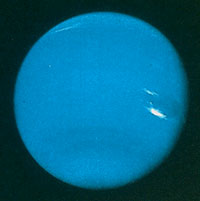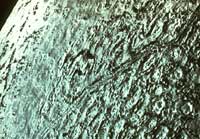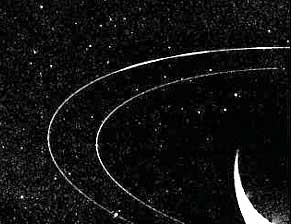World Book at NASA
 |
|
The blue clouds of Neptune are mostly frozen methane, the main chemical in natural gas -- a fuel for heating and cooking on Earth. The other object shown is Neptune's moon Triton. Image credit: NASA/JPL |
Neptune's diameter at the equator is 30,775 miles (49,528 kilometers), or almost 4 times that of Earth. It is about 17 times as massive (heavy) as Earth, but is not so dense as Earth. Neptune has 11 satellites (moons) and several rings around it.
Neptune travels around the sun in an elliptical (oval-shaped) orbit. Its average distance from the sun is about 2,793,100 miles (4,495,060,000 kilometers). Neptune goes around the sun once about every 165 Earth years, compared with once a year for Earth. As Neptune orbits the sun, it spins on its axis, an imaginary line through its center. Neptune's axis is not perpendicular (at an angle of 90 degrees) to the planet's path around the sun. The axis tilts about 28 degrees from the perpendicular position. Neptune spins around once in about 16 hours and 7 minutes.
 |
|
Bright blue clouds that surround the planet Neptune consist mainly of frozen methane. Winds that carry these clouds may reach speeds up to 700 miles (1,100 kilometers) per hour. Image credit: NASA/JPL |
Scientists believe that Neptune is made up chiefly of hydrogen, helium, water, and silicates. Silicates are the minerals that make up most of Earth's rocky crust, though Neptune does not have a solid surface like Earth. Thick clouds cover Neptune's surface. Its interior begins with a region of heavily compressed gases. Deep in the interior, these gases blend into a liquid layer that surrounds the planet's central core of rock and ice. The tilt of its axis causes the sun to heat the Neptune's northern and southern halves alternately, resulting in seasons and temperature changes.
Neptune is surrounded by thick layers of clouds in rapid motion. Winds blow these clouds at speeds up to 700 miles (1,100 kilometers) per hour. The clouds farthest from Neptune's surface consist mainly of frozen methane. Scientists believe that Neptune's darker clouds, which lie below the clouds of methane, are composed of hydrogen sulfide.
In 1989, the Voyager 2 spacecraft found that Neptune had a dark area made up of violently swirling masses of gas resembling a hurricane. This area, called the Great Dark Spot, was similar to the Great Red Spot on Jupiter. But in 1994, the Hubble Space Telescope found that the Great Dark Spot had vanished.
 |
|
The icy crust of Triton, Neptune's largest satellite, has ridges and valleys that were revealed in photographs taken by the U.S. space probe Voyager 2. Image credit: NASA/JPL |
Neptune has 11 known satellites. Triton, Neptune's largest satellite, is about 1,681 miles (2,705 kilometers) in diameter and about 220,440 miles (354,760 kilometers) from Neptune. It is the only major satellite in the solar system that orbits in a direction opposite to that of its planet. Triton has a circular orbit and travels once around Neptune every six days. Triton may once have been a large comet that traveled around the sun. At some point, Neptune's gravity probably captured the comet, and it became a satellite of Neptune. Scientists have discovered evidence that volcanoes on Triton once spewed a slushy mixture of water and ammonia. This mixture is now frozen on Triton's surface. Triton has a surface temperature of -390 degrees F (-235 degrees C), the coldest known temperature in the solar system. Some volcanoes on Triton remain active, shooting crystals of nitrogen ice as high as 6 miles (10 kilometers) above the moon's surface.
 |
|
In Neptune's outermost ring, 39,000 miles (63,000 kilometers) from the planet, material mysteriously clumps into three bright, dense arcs. Image credit: NASA |
Discovery
Neptune was discovered by means of mathematics before being seen through a telescope. Astronomers had noticed that Uranus, which they thought was the most distant planet, was not always in the position they predicted for it. The force of gravity of some unknown planet seemed to be influencing Uranus.
In 1843, John C. Adams, a young English astronomer and mathematician, began working to find the location of the unknown planet. Adams predicted the planet would be about 1 billion miles (1.6 billion kilometers) farther from the sun than Uranus. He completed his remarkably accurate work in September 1845. Adams sent it to Sir George B. Airy, the Astronomer Royal of England. However, Airy did not look for the planet with a telescope. Apparently, he lacked confidence in Adams.
Meanwhile, Urbain J. J. Leverrier, a young French mathematician unknown to Adams, began working on the project. By mid-1846, Leverrier also had predicted Neptune's position. He sent his predictions, which were similar to those of Adams, to the Urania Observatory in Berlin, Germany. Johann G. Galle, the director of the observatory, had just charted the fixed stars in the area where the planet was believed to be. On Sept. 23, 1846, Galle and his assistant, Heinrich L. d'Arrest, found Neptune near the position predicted by Leverrier. Today, both Adams and Leverrier are credited with the discovery. The planet was named for Neptune, the Roman sea god. In August 1989, the Voyager 2 spacecraft provided the first close-up views of Neptune and most of its moons. The spacecraft also discovered the planet's rings and six of its moons -- Despina, Galatea, Larissa, Naiad, Proteus, and Thalassa.
Contributor:
Bradford A. Smith, Ph.D., Astronomer, Institute for Astronomy, University of Hawaii.
How to cite this article:
To cite this article, World Book recommends the following format:
Smith, Bradford A. "Neptune." World Book Online Reference Center. 2004. World Book, Inc. http://www.worldbookonline.com/wb/Article?id=ar386900.
| › Return to Topics | › Back to Top |